Radiologia Brasileira - Publicação Científica Oficial do Colégio Brasileiro de Radiologia
AMB - Associação Médica Brasileira CNA - Comissão Nacional de Acreditação
 Vol. 46 nº 1 - Jan. /Feb. of 2013
Vol. 46 nº 1 - Jan. /Feb. of 2013
|
ORIGINAL ARTICLE
|
|
Comparative study to determine technical failures affecting conventional chest radiography |
|
|
Autho(rs): Wender Cardoso da Silva1; Márcio Alexandre Marques2; Augusto Voltaire do Nascimento3 |
|
|
Keywords: Radiography; Chest; Lung; Technical failures; Biostatistics. |
|
|
Abstract: INTRODUCTION
Chest radiography continues to be one of the imaging studies most requested by physicians for diagnosis purposes(1-3), even with the technological development of different imaging methods and processes of images acquisition. It constitutes a routine diagnostic method for evaluation of both symptomatic and asymptomatic patients with pleuropulmonary, mediastinal and thoracic cage diseases, also allowing the assisting physician to estimate the disease prognosis. Thus, there is a concern towards improving the quality in the production of such images for utilization as an aid in the diagnosis and management of chest diseases. In spite of the fact that the lungs are clearly visible at radiography, specific techniques are required for higher definition and enhancement of the analyzed structures. According to studies already undertaken by other investigators, the image quality and the radiation dose utilized in radiography are closely related to the technical characteristics and operational conditions of X-ray apparatuses, films development, film-screen combination, radiographic techniques such as tube voltage (kVp) and current (mAs), focal point, patient positioning, focus-film and object-film distances, operator's specific knowledge and patients' physical conditions (such as the case of bedridden patients, for example)(1,3). According to Freitas et al., information published by a Brazilian health organization demonstrated that in 27 X-ray apparatuses operating in the city of São Paulo, 1.7 million radiological studies are performed every year(4), and 49% correspond to chest radiographies. Consequently, the correct interpretation of the radiographic image is an important condition for the clinical and therapeutic planning, thus the relevance of the role played by the image quality in the diagnostic process accuracy. Whenever a radiographic study is not within the acceptable quality parameters, the study must be repeated, which increases the patient exposure to radiation, besides the negative economic impact for the health institution where the imaging studies are performed(5-7). On posteroanterior and lateral views, the lung is seen at radiography as a viscus with a characteristic density because of the presence of air within the pulmonary alveolar structures. Also, the posterior as well as the lateral and anterior aspects of the rib cage can be assessed and differentiated(8). The criteria for evaluation of a radiographic image follow the standards established by the European Community, such as the case of practice criteria and reference doses for patients(9). In this sense, the present study was aimed at specifying and quantifying the main parameters which directly interfere in the production and quality of conventional chest radiographic images. MATERIALS AND METHODS For the development of the present study, the authors selected 897 conventional, posteroanterior and lateral chest radiographs, over a period of approximately 12 months, between 2008 and 2009. Such images presented some type of deficiency, requiring repetition of the exams. It is important to mention that none of the images were of computed radiography or digital radiography types. The chest radiographs were obtained in radiological units with apparatuses of various brands, but with the same technical specifications. Images from bedridden patients, acquired with portable apparatuses, were excluded. The images were collected in five large hospitals in the city of São Paulo, Brazil: two private and three public institutions. With the assistance of a pulmonologist, only those images considered as being inappropriate for radiological diagnostic purposes, requiring repetition of the radiographic procedure, were included in the present study. The radiographs were grouped and labeled according to type or types of failure incurred during their acquisition, as shown in Table 1. Then, the data were entered into tables according to type of failure and hospital from which the images had originated. 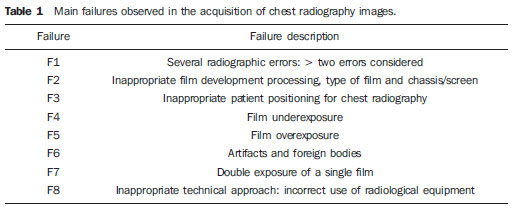 The results were then analyzed by means of parametric and non-parametric tests, according to indication and type of variable. Initially, a statistical analysis was performed in order to verify whether the failures followed an independent distribution pattern, and the variables were described by mean (± standard deviation) and compared by means of Poisson probabilities distribution expressed as counts(10). In order to accurately evaluate the presence of similarity among the data, the Pearson's correlation coefficient was utilized together with the t-test for correlation. The non-parametric Kolmogorov-Smirnov (KS) test was utilized to evaluate whether the distribution of relative frequencies of two independent samples could be considered as being from a same population. Two data sets were organized for such KS test, one from private hospitals and the other from public hospitals. The data were analyzed with software Statistical Package for the Social Sciences, release 9.0 for Windows and those results considered as being significant obtained probability (p) of error α > 5% (p > 0.05). RESULTS Figure 1 shows the chart of relative frequency of failures observed on the radiographic images from each hospital. By means of such a chart, one may observe that, in general, the failures distribution is apparently similar, i.e., if the relative frequency curves were superimposed, the resulting curve would be similar to any of the individual relative frequency curves. The pattern in this chart (Figure 1) suggests that the ratios of a given type of failure must be, with a certain degree of confidence, equal to each other, and that each type of failure presents a particular distribution, independently from the hospital from which the images originated. 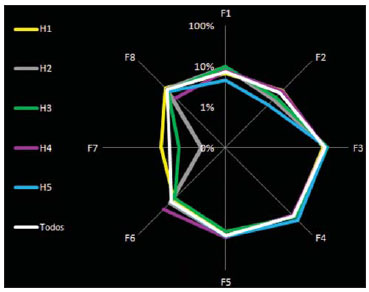 Figure 1. Relative frequency versus failures. Logarithm of the relative frequencies as a function of the failures (F, failure; H, hospital). For a more accurate evaluation of the association between the frequency distributions, a matrix of Pearson's correlation coefficients between such distributions was built, as shown on Tables 2 and 3. Each hospital was identified by letters A and B - private hospitals - and C, D and E - public hospitals. 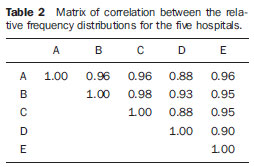 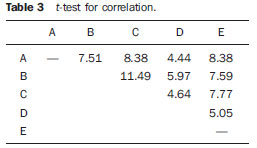 Table 2 shows that the correlation coefficients may be significant. The t-test for correlation was utilized to evaluate the significance of such coefficients. Such results are shown on Table 3. The KS test was utilized to evaluate whether the relative frequency distributions between the two independent samples could be considered as being from a same population. The null hypothesis of the KS test is H0: The accumulated distributions of the failures ratios of the two samples belong to the same population. For such a test two data sets were created, one from the private hospitals and another from the public hospitals. The KS test results are shown on Table 4. One observes that there are both differences and similarities between the accumulated frequencies. The differences were not significant, i.e., with 5% significance in the KS test for two independent samples, one can say that all data from both private and public hospitals are from a single population. 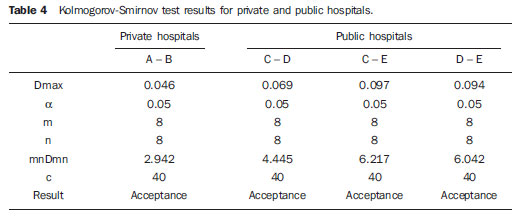 Table 5 shows the KS test results for all hospitals (both private and public) and it indicates that the data from all of them may be grouped into a single sample of a single group of failures. Such a result can be seen on Figure 2, where the failures frequencies for all hospitals are defined. 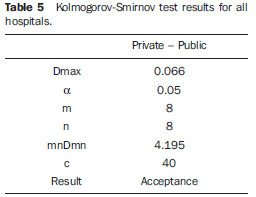 DISCUSSION The study developed by Al-Malki et al.(1) has demonstrated that among 8,887 exposed films from 5,412 patients, the rate of radiography repetition was 7.93%. Overexposure, underexposure and inappropriate patient positioning were the main contributors, comprising 32.91% of the failures leading to radiography repetition. The results obtained in the present investigation were practically the same, except for the sole difference that, in the present study, the requested imaging study was conventional chest radiography. Additionally, the results demonstrated that the repetition index due to the same type of failures was approximately 65%, corresponding to incorrect patient positioning reaching 27%, underexposure 23%, and overexposure reaching 15%, as demonstrated on Figure 2. Also, the technical failures observed on the conventional chest radiographs from private hospitals were basically the same found on the radiographs from the public hospitals. Thus, it was demonstrated that the sampling was related to a single group of failures and that their frequencies are the same. 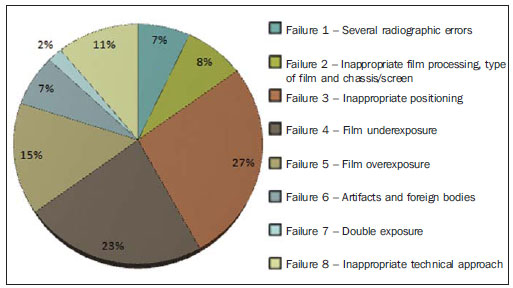 Figure 2. Distribution of total frequencies of failures. Failure frequency in private and public hospitals. As regards the image quality criteria, a conventional radiography compliant with such criteria will certainly be appropriate as a parameter for diagnosis, clinical investigation or medical follow-up. A conventional radiography of excellent quality fundamentally depends upon the operator training, and such operator, in the absence of a radiologist, must be capable of deciding whether the image is appropriate, and that is easier as the quality criteria are known. Qualified and experienced professionals, as well as investment in training and courses, are efficient measures which contribute for the improvement in the radiological units quality standards. In order to provide radiology professionals with guidance, national and international radioprotection standards were developed to minimize possible biological effects of radiation and, by means of laws, regulations and guidelines from the Ministry of Health - Ordinance 453/98 -, the need for quality assurance programs has been indicated. CONCLUSION Based on the presented results, it is possible to conclude that the data obtained in the present study originate from a single group of failures, i.e., independently from the classification of the hospitals into public or private institutions. Additionally, as a function of the observed technical failures, the cause for the encountered pattern should be investigated, i.e., why the F3 failures (inappropriate patient positioning for chest radiography), F4 (films underexposure: technical factors included) and F5 (films overexposure: technical factors included), have occurred with a higher frequency. The observed results have also indicated that the radiological apparatuses quality control is a relevant factor in the obtention of excellent conventional radiographs, and that further studies should be undertaken to determine the impact of such quality control on the appropriateness of the radiographic images. REFERENCES 1. Al-Malki MA, Abulfaraj WH, Bhuiyan SI, et al. A study on radiographic repeat rate data of several hospitals in Jeddah. Radiat Prot Dosimetry. 2003;103:323-30. 2. Kotsubo MTK, Marchiori E, Azevedo ACP. Estudo dosimétrico de radiografias de tórax com o emprego de técnicas de alta quilovoltagem. Radiol Bras. 2003;36:163-7. 3. Ney-Oliveira F, Silvany Neto AM, Santos MB, et al. Relação entre a qualidade do exame clínico e o acerto na requisição da radiografia de tórax. Radiol Bras. 2005;38:187-93. 4. Freitas MB, Yoshimura EM. An overview of doses to patients and irradiation conditions of diagnostic chest x ray examinations carried out in hospitals of the city of São Paulo, Brazil. Radiat Prot Dosimetry. 2003;103:141-8. 5. Magalhães LAG, Azevedo ACP, Carvalho ACP. A importância do controle de qualidade de processadoras automáticas. Radiol Bras. 2002;35:357-63. 6. Oliveira ML, Khoury H. Influência do procedimento radiográfico na dose de entrada na pele de pacientes em raios-X pediátricos. Radiol Bras. 2003;36:105-9. 7. Pacheco JG, Santos MB, Tavares-Neto J. Avaliação dos serviços de radiodiagnóstico convencional de dois hospitais da rede pública estadual de Rio Branco, Acre. Radiol Bras. 2007;40:39-44. 8. Narahashi E, Yamada AF, Hernandez Filho G, et al. Avaliação das costelas através da imagem. Rev Bras Reumatol. 2006;46:137-40. 9. Osibote AO, Azevedo ACP, Carvalho ACP, et al. Patients exposure and imaging quality in chest radiographs: a critical evaluation. Radiol Bras. 2007;40:119-22. 10. Vieira S. Introdução à bioestatística. Rio de Janeiro, RJ: Elsevier; 2008. 1. Master, Teacher at Universidade de Mogi das Cruzes (UMC), Mogi das Cruzes, SP, Brazil. 2. PhD, Professor, Universidade Estadual Paulista "Júlio de Mesquita Filho" (Unesp), Sorocaba, SP, Brazil. 3. MD, Pulmonologist, Service of Respiratory System Diseases, Hospital do Servidor Público Estadual (DAR/HSPE), São Paulo, SP, Brazil. Mailing Address: Wander Cardoso da Silva Praça Monte Cristo, 35, ap. 2, Jardim Cliper São Paulo, SP, Brazil, 04827-180 E-mail: wendercardoso@yahoo.com.br Received August 15, 2012. Accepted after revision December 17, 2012. * Study developed at Universidade de Mogi das Cruzes (UMC), Mogi das Cruzes, SP, Brazil. |
|
Av. Paulista, 37 - 7° andar - Conj. 71 - CEP 01311-902 - São Paulo - SP - Brazil - Phone: (11) 3372-4544 - Fax: (11) 3372-4554